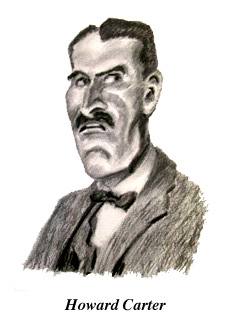
Or is it TutankhAMEN? Possibly TutankhAMON? TutENKamun, maybe? Or even TOUATANKHAMANOU?
Actually the official academic spelling of Tut's name is something like twt-'nk-'imn. Since the Egyptians didn't write out the vowels, you can pronounce it pretty much as you like. But Tutankhamun is probably pretty close.
We also know how he spelled his name. It was
![]() .
Egyptian names make up phrases or sentences and Tut's name has three
words:
.
Egyptian names make up phrases or sentences and Tut's name has three
words: ![]() ("tut"
or "image"),
("tut"
or "image"), ![]() ("ankh"
meaning "life" or "living"), and
("ankh"
meaning "life" or "living"), and ![]() "Amun"
(the Egyptian god "Amun"). There are variant interpretations of what
the name means, the most straightforward being "The Living Image of
Amun". But note that if you read the words in the order, it comes out
"Amun-Tut-Ankh". On the other hand, Rameses,
"Amun"
(the Egyptian god "Amun"). There are variant interpretations of what
the name means, the most straightforward being "The Living Image of
Amun". But note that if you read the words in the order, it comes out
"Amun-Tut-Ankh". On the other hand, Rameses, ![]() ,
is written as it's spelled:
,
is written as it's spelled: ![]() ,
the circle with a line = "Ra";
,
the circle with a line = "Ra"; ![]() the three-legged-whatchamacalit, = "mes"; and finally,
the three-legged-whatchamacalit, = "mes"; and finally, ![]() ,
the two bolts of folded cloth = "double s".
,
the two bolts of folded cloth = "double s".
To make matters even more confusing, Tut had
another name,![]() ,
or "Neb-Kheperu-Ra" as Egyptologists transcribe it. That's what's
called his praenomen or throne name and with which he was
dubbed when he became king. The trouble here is that this name is
written completely backwards: that is Ra-Kheperu-Neb. The
circle with the line,
,
or "Neb-Kheperu-Ra" as Egyptologists transcribe it. That's what's
called his praenomen or throne name and with which he was
dubbed when he became king. The trouble here is that this name is
written completely backwards: that is Ra-Kheperu-Neb. The
circle with the line, ![]() ,
again is Ra;
,
again is Ra; ![]() ,
the bug with three lines = kheperu; and
,
the bug with three lines = kheperu; and ![]() ,
the bowl is neb.
,
the bowl is neb.
The rationale, we are told, is Egyptians put the names of the gods first even if they were pronounced later. So you have to put both gods, Ra and Kheper, before the ordinary word, neb, (a word of various meanings including, "all"). And the word kheperu had meanings other than a god's name, and if you look at the pictures in the fancy glossy books about Tut, you'll always see his name written totally backwards. So shouldn't his name be Kheperu-Neb-Ra?
Well, probably not. There are two variations in CooperToons knowledge - one that appeared in the book Monuments by Jean-Fancois Champollion (who deciphered the hieroglyphics) and the other a hieratic inscription - that is the abbreviated form of hieroglyphics - from Tut's tomb. In both these the neb comes before the kheperu. We also have cases where the pharaoh who was likely Tut's grandfather had a throne name where two of the characters occasionally switch back and forth. So Neb-Kheperu-Ra is probably correct.
But there is certainly no need to explain who King Tut is. Even the most avid watchers of Spike TV and listeners of Howard Stern know he was that Egyptian boy-king whose tomb was discovered with all the goodies still in place. So if you want to learn more, read on!
Part I: Tut and his Times
Tut was Pharaoh during Ancient Egypt's Eighteenth Dynasty. This was a line of kings started out by the Pharaoh Ahmose. Ahmose's main claim to fame was he was the guy who booted out the Hyksos kings. The Hyksos were a group of foreign rulers that had been in Egypt for about a hundred years. By kicking them out, Ahmose naturally became a hero to the later generations of Egyptians.
The Eighteenth Dynasty was the beginning of the period in Egyptian history known as the New Kingdom. The New Kingdom spanned the time beginning sometime between 1600 to 1500 BC and extended to maybe as late as 1000 BC. Typical dates are quoted like 1540 to 1070. Times are naturally approximate, but most historians say Tut himself began to rule sometime in the middling 1300's BC, and he was Pharaoh for about nine years.
Tut is often dismissed as a ruler of minor importance, but that's not really true. Part of his historical brushoff is that he came to the throne as a kid (he was about nine), and a grown-up named Ay probably actually pulled the strings. Ay became Pharaoh (briefly) after Tut, and he in turn was succeeded by a general named Horemheb. Horemheb was the last king of the Eighteenth Dynasty and also had the disputable distinction of once being portrayed by beefcake actor, Victor Mature.
If you read a book about Tut, you'll find it doesn't have much to say about him. Instead, they talk mostly about the two kings before Tut. These were the Pharaoh Amenhotep III and his son, Amenhotep IV. Part of the problem is simply practical. You can write all we know about Tut in less than a page, and yet a learnéd scholar can dash off a 400 page book about the two Amenhoteps without much trouble. But what made Tut important was he cleaned up the mess left by Amenhotep IV.
Amenhotep IV, it turns out, was either a
visionary or a nut depending on your point of view. 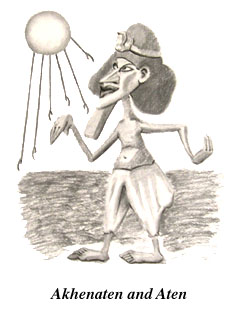 What
he did was to decree there was only one true god, a god who was all
pervasive and everywhere. His god created the earth, the heavens, all
life, and all the creatures. If this sounds a bit familiar and
precedent sitting, Amenhotep IV did depart from later more familiar
teachings in a couple of ways. First, only he - the Pharoah - could
really "know" the god. And second, his god had a visual
manisfestation (whatever that means) in the aten.
What
he did was to decree there was only one true god, a god who was all
pervasive and everywhere. His god created the earth, the heavens, all
life, and all the creatures. If this sounds a bit familiar and
precedent sitting, Amenhotep IV did depart from later more familiar
teachings in a couple of ways. First, only he - the Pharoah - could
really "know" the god. And second, his god had a visual
manisfestation (whatever that means) in the aten.
The word aten is written in Egyptian
as![]() and originally was just a word for the disk of the sun. But in
Amenhotep IV's theology it became to mean the god himself (or
itself). So when he changed his name to Akhenaten. This is usually
translated as something like "One-Who-Is-Beneficient-To-The-Aten"
whatever the heck that means. An earlier and less cumbersome translation is
"The Spirit of Aten" which seems to have fallen out of favor with Egyptologysts.
But in any case Akhenaten kept with the half-backward renditions of Egyptian
names and spelled it
and originally was just a word for the disk of the sun. But in
Amenhotep IV's theology it became to mean the god himself (or
itself). So when he changed his name to Akhenaten. This is usually
translated as something like "One-Who-Is-Beneficient-To-The-Aten"
whatever the heck that means. An earlier and less cumbersome translation is
"The Spirit of Aten" which seems to have fallen out of favor with Egyptologysts.
But in any case Akhenaten kept with the half-backward renditions of Egyptian
names and spelled it ![]() .
.
Akhenaten was unique among Pharaohs in that he didn't mind if his artists and sculptors showed him as he was - with a long face, skinny arms, and a big toches. He is without doubt one of the most interesting rulers in the history of the world and well worth studying. Naturally, most people have never heard of him.
Most people, though, do know about his
wife, Nefertiti, ![]() .
Or at least they've seen pictures of the statue of her with the big
hat that's now in the Egyptian Museum in Berlin. Akhenaten and
Nefertiti appear to have been happily married and affectionate, an
arrangement that produced no sons, but seven daughters. Their third,
Ankhesenpaaton,
.
Or at least they've seen pictures of the statue of her with the big
hat that's now in the Egyptian Museum in Berlin. Akhenaten and
Nefertiti appear to have been happily married and affectionate, an
arrangement that produced no sons, but seven daughters. Their third,
Ankhesenpaaton,![]() , would marry Tut.
, would marry Tut.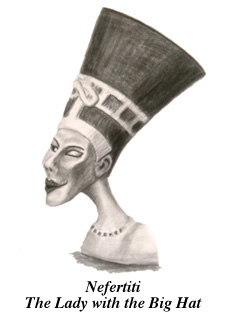
Some people have suggested it was really Akhenaten who first came up with the concept of a single all-powerful god. This idea has led others to theorize that he was the guy who got the Hebrews (and therefore ultimately the Christians) hooked on monotheism. Proponents of this idea point out that "Aten" and the Hebrew "Adonai" ("Lord") have similar consonants and that there are striking parallels between Akhenaten's "Hymn to Aten" and the 104th Psalm.
Certainly, there are some parallels particularly if you translate them with similar wording. But similar phrasing doesn't prove influence. Nowadays it seems most Egyptologists seem skeptical of the idea that Moses was a follower of Akhenaten. Perhaps the greatest argument against the theory is that Freud liked it.
The truth is Akhenaten's doctrine had a long and venerable history. It was, in fact, based in the worship of one of the oldest gods in Egypt, Ra. Nor was the concept of one supreme god unique. The biggest shock to anyone old enough to remember the Egyptian swords and sandals movies with all the gods with the funny animal heads is that the concept of monotheism was nothing new in Egyptian theology.
In Egyptian texts (written even before Akhenaten) you can find statements that maintain there is only one true god, and there are no others. Now to get around the fact there were others, the extras were merely pooh-poohed as the Big Guy's manifestations. Scrolls might talk about different gods, but they might also say that when this-and-that god appears he's just a form of that-and-this god. The average Egyptians probably didn't bother splitting hairs about what it all actually meant. They left that for the priests - and the Pharaoh.
Akhenaten's real contribution (if you want to call it that) is that he instituted intolerance as part of his religion. Before then Egypt had been particularly relaxed regarding variant beliefs. This was only to be expected in a large united country where each city had it's own favorite god. No one knows who the first Pharaoh was (most Egyptologists pick a guy named Narmer), but whoever it was, when he united Egypt, he let everyone keep worshiping as they pleased. Then those who believed in the One-God-Many-Manefestations theology could go on thinking their god was the Big One.
But Akhenaten would have none of it. Although early in his reign he permitted worship of the other traditional gods, at one point he suddenly banned all the old religions. There was to be none of this your-god-is-my-god business either. You had to worship his god, Aten.
Why the change no one knows. Possibly his mother, Tiye, died, and with her went a firm restraining hand. But whatever the reason Akhenaten came down particularly hard on Amun, the traditional god of the town of Thebes which was at the site of modern-day Luxor.
Starting out as a minor local deity, by the middle of the Eighteenth Dynasty, Amun had grown to become the most powerful god in Egypt. The Amun priesthood had become filthy rich and politically powerful - Egypt's television evangelists, you might say. But for the moment they couldn't do much. Akhenaten was, after all, the king, and the king can do what he likes.
The real problem with all this, though, was that the New Kingdom Pharaohs lived in Thebes. Now getting rid of Amun in Thebes was kind of like banning Catholicism in Vatican City. Archeological evidence also indicates the people in Thebes said to heck with the king and continued to worship as they wanted. So it's a sure bet that Akhetaten's popularity poll hit an all-time low for Pharaohs.
Well, if Thebes wouldn't play by his rules,
he'd just take his Aten, and go home. But since he already
was home, he had to build a new one. After being king for
about four years, he pulled up stakes and left Thebes. He built a new
capitol city totally from scratch. He called it "The Horizon of
Aten", Akhetaten, ![]() (spelled
backwards again), and it was about 200 miles to the north of
Thebes.
(spelled
backwards again), and it was about 200 miles to the north of
Thebes.
Tut was born about midway through Akhenaten's
reign, probably in Akhetaten. But he was not born as Tutankhamun. At
that time and place, if a kid said the word "Amun" he would probably
have gotten his mouth washed out with soap, that is, if the Egyptians
had soap. Certainly, the word "Amun" was not to be used in polite
(sc. Akhenaten's) company. So Tut's full birth name was TutankhATEN,
![]() .
.
Anyway, Akhenaten ruled about 17 years. Toward the end he picked a young man named Smenkhara to rule as a co-Pharaoh. Smenkhara is a shadowy figure in Egyptian history, and there is some reason to believe he was Tut's brother. At this point Nefertiti may have died or was keeping a low profile. It has raised not a few eyebrows that Smenkhara adopted Nefertiti's titles and official name. That, plus some highly companionable representations thought to be Akhenaten and Smenkhara have some people thinking they did not (wink, wink) keep steady with traditional Egyptian family values. Then Akhenaten either died or was overthrown.
Smenkhara evidently did not rule by himself more than a couple of years, if at all. Tut then became king. Probably from the prodding of Ay, he changed his name from Tutankhaten to Tutankhamun. It was Tut who officially restored the traditional worship of the old gods. Eventually everyone cleared out of Akhetaten and moved back to Thebes.
No one knows for sure who Tut's parents were. Opinion leans a bit toward his dad being Akhenaten, and his mom was possibly one of Akhenaten's secondary wives, a lady named Kiya. But even that's iffy. Other's think he was a brother of Akhenaten, and so his parents were really Amenhotep III and Tiye (a lock of Queen Tiye's hair was buried with him). The truth is, though, that Tut may not even have been of the royal family. In that case his marriage to Ankhesenpaaton was needed to give him a legitimate claim to the throne.
The original examination of the mummy found Tut was between 18 and 20 when he died, a finding that remains unchanged by later studies. He was succeeded as Pharaoh by Ay who almost certainly had been in charge all along.
Ever since he was dug up, people have been
trying to figure out why Tut died so young. An X-ray of his mummy
taken in 1968 showed what looked like bits of loose or chipped bone
in his skull. That itself meant nothing since embalming was a pretty
vigorous procedure back then. Of course, the original archeologists
had to chop the poor fellow up to get him out of the mummy case. So
you wonder whether anyone can tell what killed him from the
condition of the body. Still the X-ray also showed a somewhat thinner
than average bone at the base of his skull plus a smudge of the film
that could have been a blood clot. This has led some historians to
think Tut could have been murdered by a smack on the noggin.
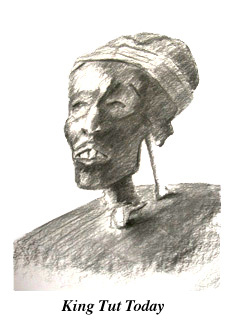
But a more recent appraisal (2003) of the X-rays opined that there was no evidence of a blow to the head. The "thinning" was due to just a normally thin part of the skull plus the angle of the head during the X-ray. Furthermore it looked like the suspicious bone chips in Tut's head were from the vertebrae. The best guess here is the bones got pushed into Tut's cranium when the archeologists cut off his head to get it out of the golden funeral mask. As you might expect, Tut does not look so hot today.
Finally in 2005, to get to the bottom of the matter, Egypt's Supreme Council of Antiquities gave the go-ahead to run a CAT scan on Tut's mummy. His head looked fine (relatively speaking) with no sign of an injury. But there was an apparent leg fracture although opinion was divided whether this occurred while the king was alive. For what it's worth, the opinion of this Merry History is that it was not (see the last footnote in Part III).
In any case, Tut was buried in the Valley of
the Kings across the river from Thebes. Ay, to legitimize his being
Pharaoh, may have married Tut's widow (renamed Ankhesenamun,
![]() ,
after her father died). Ay ruled a scant four years, probably dying
of old age before being followed by the nineteen year reign of
Horemheb.
,
after her father died). Ay ruled a scant four years, probably dying
of old age before being followed by the nineteen year reign of
Horemheb.
Tut's tomb was small for a king, probably because his early death caught everyone off the hop. Early on tomb robbers had managed to break in and do some pilfering. Tell-tale signs - like some rings tied in a headscarf and tossed on the floor - indicated that some, at least, might have been caught.
But they didn't get away with a whole lot. The tomb was given a perfunctory tidying up, and the thieves' tunnel refilled. About a hundred years later the rock and dirt from digging another tomb was tossed over Tut's, and the location was lost. So when the era of massive tomb robberies began around the Twenty-First Dynasty, no one got around to bothering Tut.
Part II: Howard, Tut, and the Tomb
As far as Tut was concerned (if indeed he was), nothing happened for the next three thousand years. Then on November 4, 1922 the British archeologist, Howard Carter, hit the first stone step leading down to the tomb. Howard was then 48 and had been everything from an artist to an assistant to Sir Flinders Petrie, arguably the first modern archeologist. Howard finally rose to become the Chief Inspector of Antiquities for the Egyptian government. Not bad for a guy who had hardly gone to school.
But a combination of a fractious personality
and trying to do his job right ended up in Howard getting sacked from
his government post. When some rich fat-cat tourists got rowdy at one
of the Department of Antiquities sites, he told them to beat it. They
complained to Howard's boss, Gaston Maspero, and Gaston told Howard
to apologize. He refused and was replaced as Inspector by his fellow
archeologist Arthur Weigall. Oddly enough, it was Arthur who in 1912
found a tomb that people originally thought was Tut's. Of course,
Arthur had not found Tut's tomb, but more on that later.
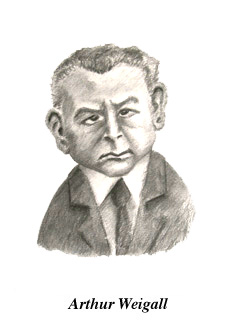
From then on Howard kept himself afloat at least in part by dealing in antiquities. He had enough contacts in the business so he became quite successful, at times dealing with major museums on a massive scale. But to get a bit more steady income he also began engaging in free lance archeology funded by people who had the money and the inclination to so indulge.
In Howard's case his "patron" (as the guys with the dough were called) was George Herbert, who was also England's 5th Lord Carnarvon. Like many English lords, George was loaded, but unlike other English lords, George did not sit in Parliament, practice law, or run breweries. His hands were pretty full, though, keeping up and running his estate and raising his Thoroughbred race horses, the latter being a business at which the Carnarvon family excels to this day.
As George got older - and particularly after a
severe automobile accident almost killed him - he found the cold
weather brought on all sorts of aches and pains. So he began spending
the English winters in Egypt. Like many people, rich and poor, young
and old, he became fascinated with the land and it's history.
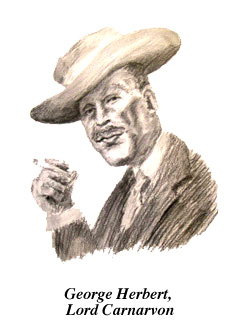
So George decided to fund archeological digs. But the Egyptian Department of Antiquities wouldn't let him (or anyone else) just wander in willy-nilly with a pick and spade and start to flail about the tombs. They required special permission to excavate a clearly specified area. Everything had to be drawn up in a written contract, called a concession, and there also had to be a real archeologist to supervise the digging. So when George spoke to Gaston about starting a dig, Gaston recommended Howard. The two men started digging in 1907.
It's said that opposites attract, and that seems to have been the case here. George was a quite unpretentious fellow who genuinely liked people. On his travels he'd just as soon talk with a railroad porter as an ambassador, if indeed he didn't prefer the former.
Traveling around was what George liked to do while his wife,
Almina, preferred to stay in England (although she did sometimes visit
Egypt). Although later events showed that their marriage was not quite
in keeping with official British family values, on the surface it was not
too different from other unions of British nobility. ON the other hand,
George did like to travel with his daughter, Lady Evelyn Herbert,
who was pretty and energetic and a real daddy's girl.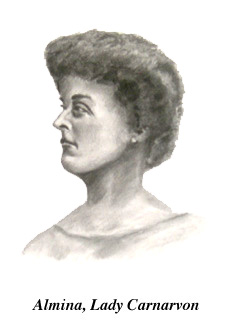
Howard, though, was a different matter. People who worked with him found him to be a chronic complainer who seemed to get his jollies out of irritating people. He was the type of guy who when riding a train would literally go up front and harangue the engineer for giving him such a bumpy ride. He was, in short, a pain in the rear end. So it's no surprise that at one time or another Howard ended up alienating just about everyone he knew.
For now Howard and Lord Carnarvon (as we'll respectfully call him) had pretty good luck. They found a number of tombs and artifacts and all in all Lord and Lady Carnarvon (who often went along on the digs) had a fine time. It could be a bit hazardous, though. At one spot the excavators were literally chased from the site by a huge number of cobras and vipers. But they kept digging.
Of course, excavations were not just funded by rich English lords, and there was a lot of competition. One of the more important concessionaires was Theodore Davis, a wealthy American lawyer.
Theodore had been digging in Egypt since at least the turn of the century, mostly around Thebes. Theodore also held the exclusive concession that Howard and Lord Carnarvon wanted. That was in the Valley of the Kings, and it was there that the most famous Pharaohs had been buried.
By the time serious digging began in Egypt in
the late eighteenth and early nineteenth century, what remained of
the tombs were mostly long dark corridors extending into the ground.
Little remained of their funerary finery. The ceilings of some had
collapsed and massive floods which washed into the valley about every
200 years had filled some tombs almost from top to bottom with
rubble. So the archeologists in the Valley of the Kings, far from
being grave robbers and despoilers of the dead, spent most of their
time simply clearing the now dilapidated tombs of rock and dirt. What
objects they found, although not always insignificant, represented
only a fraction of what the original burials contained. Nature, though, was not the real culprit for the current state of
affiars. Most of the problems had been caused by the Ancient
Egyptians themselves.
Nature, though, was not the real culprit for the current state of
affiars. Most of the problems had been caused by the Ancient
Egyptians themselves.
Tomb robbery in Egypt was quite an institution in itself. Deals struck between the thieves and the guards at the tombs insured that portable stuff could be carried away easily. Almost as soon as the king was buried his goods began to get carted off. At one time or another every tomb had been entered and robbed at least to some degree.
The robbers were also most discourteous to their king's mortal clay. They routinely broke the mummies apart to get at the jewels and gold wrapped up in the bandages, often smashing through the chest cavities to get at the jeweled scarab that replaced the Pharaoh's heart. They'd break off the arms and legs and toss them aside. Then for good measure, they might set the whole body on fire.
So for a long time, only one Pharaoh's mummy - Amenhotep II, Akhenaten's great-grandfather - had been found in it's near empty tomb, completely pilfered of its finery and rather the worse for wear. No Pharaoh had ever been found in it's tomb undisturbed and as the priests had left him.
As it is, virtually every mummy of a Pharaoh you see in books or if you visit the Cairo museum were not, that's not, found in their tombs. What happened was that around the Twenty-first Dynasty the priests took an inventory, and saw that the tombs were plundered beyond repair and the Pharaohs had been chucked aside like chicken bones after a picnic. So they took some of the mummies and put them in the tomb of Amenhotep II. But even more mummies were moved out of the Valley altogether to a tomb in nearby Deir El-Bahri. There most of the famous Pharaohs were hidden until they were found in 1881. Amenhotep II's tomb was discovered in 1898.
Actually there was one more (probably) royal mummy that was found in its tomb - or rather in a tomb where it was probably reburied. In 1907, Theodore Davis and Arthur Weigall had found a ransacked tomb, now called KV55. Some of the funerary equipment was there including part of the guilded wooden partitions (the shrine) that enclosed the sarcophagus. The shrine showed Akhenaten leading his mother, Queen Tiye, by the hand. From that and various inscriptions Theodore assumed the tomb was that of Akhenaten's mom.
Among other odds and ends there was a badly mutilated coffin containing a mummy. According to some accounts as soon as the mummy was exposed to air, it crumbled to dust, leaving behind the skeleton. The bones were identified on the spot as being a woman, and so Theodore and Arthur believed they had also found what had been the mummy, and was now the bones, of Queen Tiye.
It's worth pausing a moment to review the various scientific studies on the bones as it illustrates what sometimes happens in Egyptology. After more than a hundred years, multiple studies with the latest scientific methods, and exhaustive and impartial evaluation, we still don't know exactly what went on.
In 1907, Elliott Smith, a chemist by training
but an expert in the examination of mummies, decided to look at the
bones more thoroughly. Expecting to be studying the bones of a middle
age to elderly woman, he found he was looking at the skeleton of a
young man. From the unusual shape of the skull and the circumstances
he believed they had the bones of Akhenaten himself. Although the
estimated age, 20 to 26, seemed too young, Elliott felt the circumstances
of the excavation - that is, the mutilated coffin - pointed to
Akhenaten.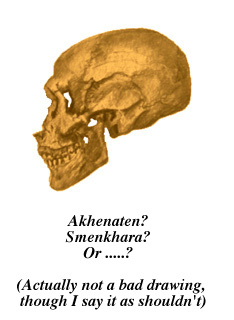
But in 1931, Dr. Douglas Derry, a professor of anatomy at Cairo, also found the bones to be a young man. There was no sign of any abnormalities or disorders, and the age was 23 at most. This was too young to be Akhenaten. The most likely candidate, then, was Smenkhara and based on the similarities with Tut's skull, Dr. Derry guessed the two young men were brothers.
Over thirty years later, in 1963, an anatomist at Liverpool University, R. G. Harrison, took a look. His study was much more detailed and wasn't published until 1966. He also ran serological tests and concluded that whoever had owned the bones was the full brother of Tut. The age was 18 - 22. So it still looked like it was Smenkhara.
But then in 1988, Fawzia Hussein and James E. Harris (the latter being a well-known specialist in X-raying Pharaohs) looked again. What they had, they said, was a man of about 35. They felt pretty sure about their findings and presented them at a conference but have not published them in a journal. But for some this pointed to the bones once more being Akhenaten.
Is there more? Yep. In 2000, Joyce Filer examined "Akhenaten's" bones once more. The molars weren't completely erupted, and some of the bones weren't completely fused. So the age estimate was back to between 20 and 25, probably at the low end. So it's Smenkhara again!
Then end? As Big Jake would say, "Not hardly!". In 2010, DNA analysis was run on a number of mummies including the bones found in KV 55 and a female mummy found in the Tomb of Amenhotep II. The conclusions were that the two individuals were the father and mother of King Tut. Furthermore, the authors say - while being mum on the lack of bone fusion and state of the molar eruption - that there is an arthritic condition in the male mummy that is unlikely to have occurred in a young man in his twenties. So the mummy is most likely middle aged and in his forties. So it's Akhenaten, again!
Well what can you say? There seems to be only one possible explanation.
Yes. We've finally found Judge Crater.
Well, back to the story. Theodore continued digging and over the years had pretty good luck. But by 1915, he had decided the Valley of the Kings has been completely dug up and relinquished his concession. This was what Lord Carnarvon and Howard had been waiting for. They snapped it up.
But why in the world would Lord Carnarvon and Howard want to dig in an exhausted and empty valley? Well, for one thing, they didn't believe the Valley of the Kings had been exhausted. They were, in fact, certain that one particular tomb was still there, and that was the tomb of Tutankhamun.
Howard's reasoning was both simple and, as it
turns out, correct. Although Theodore and Arthur had reported they
had found Tut's tomb in 1912, Howard knew they had not. Herbert
Winlock, then curator of the Egyptian Department at the Metropolitan
Museum of Art in New York, had figured that out for him.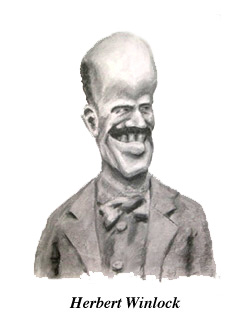
Herbert Eustis Winlock was a true rare bird - an aggressive savant in his field, an intellectual ball of fire, and a nice guy. He was also quite a character. A graduate of Harvard, Herbert had worked at the Metropolitan Museum in New York from the age of twenty-two and eventually would rise to become the museum's director. He loved hands-on excavation, and from time to time he would drop by to visit Theodore and other archeologists who were excavating near where the Met was digging.
Now Herbert saw some clay jars sitting around from what Theodore thought was Tut's tomb. Inside there was some rather indefinable junk and Herbert asked what they were. Theodore just shrugged his shoulders. Herbert then asked if the Met could have them for "study", and Theodore said, sure, take them.
Herbert didn't look at the jars for quite a while, but when he did he recognized he had the remains of the funerary banquet of Tutankhamun. He even figured out how many people were there (eight) and what they ate (ducks, geese, and mutton). When everyone was done, they had cleaned up with whiskbrooms and buried the stuff. So what Theodore had found was not Tut's tomb, but the "funeral cache". At one point Herbert told Carter about it.
So now Howard knew that Tut's funeral banquet had taken place in the Valley of the Kings. And that meant Tut himself had been buried in the Valley and probably not far from the cache. More to the point, of all the Pharaohs virtually no artifacts with Tut's name had ever shown up on the antiquities market. That meant they were still in the ground. Ergo, Tut's tomb had never been found.
For seven years, Howard and Lord Carnarvon kept digging. But still they found nothing. By 1922, Carnarvon himself had just about given up. For all the money and time spent, he and Howard had nothing to show for their work but a few odds and ends and holes in the sand. Howard asked for one more year, even if he had to pay for it himself. By now Howard and Lord Carnarvon were good friends, and Carnarvon agreed to fund one more season. Howard returned to Egypt.
Talk about funny coincidence department. Howard started digging on November 1, 1922, and within three days he struck the first step leading down into the ground. When the workmen dug out the passageway, he found they had stumbled on what was then (and remains) the only intact tomb of a Pharaoh. However, for technical reasons (discussed below), Howard tried to make a case that it was not intact, but been robbed in antiquity. That was true, it had, but that had nothing to do with whether it was intact.
Tut's tomb consisted of four small rooms literally packed with thousands of objects that could completely fall apart at the touch of a Twentieth Century hand. Howard might have been a grump, but he was a highly responsible archeologist. In fact, he was probably the best there was, and he knew he couldn't handle Tut's tomb all alone.
Fortunately, Howard did have some friends besides Lord Carnarvon, and he called on them for help. That included Herbert who was with the Met's team excavating nearby. You have to say that Herbert had what probably was the best job in the world. He was the curator of the Met's Egyptian Department at the time when the Egyptian government gave any excavators a 50/50 split of whatever they found. While the Greek and Roman excavator's labored years for a few chunks of statues with broken noses and relied more often on unscrupulous dealers to fill the shelves of the museums, Egyptologists could be more than content on literally what picked up from the ground.
But now the one-for-you-and-one-for-me
archeology was under attack. Part of the problem was that Gaston, the
old easy going Director of Antiquities, had died six years earlier.
His replacement was Pierre Lacau, a French scholar who thought that
the Egyptians - or at least the Egyptian Department of Antiquities -
should get a bigger cut of the pie.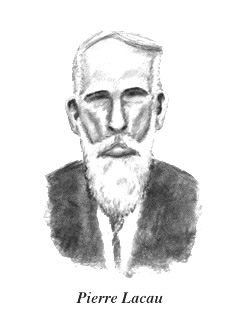
But for the moment the old agreements stood. There was, though, a catch - a big catch - you might even say a humongous catch. If an archeologist found an "intact" tomb, then the agreement of equal divisions of the artifacts was null and void. Then the Egyptian Department of Antiquities could claim everything.
The reasoning was simple (and correct). The collective value - historical and monetary - of objects from an intact tomb would be so far above that of the individual objects that such a find should not be split up. They should remain together and belonged, not in a rich man's front parlor, but - to quote Indiana Jones - in a museum. In principle no one disagreed with this idealistic arrangement, partly at least because no one thought they would ever find an intact tomb.
However, they had. In 1905, once again Theodore Davis and his then-archeologist, James Quibell, discovered still another tomb in the Valley of the Kings. This was of a nobleman, Yuya, and his wife, Thuya. They also happened to be parents of Tiye, mother of Akhenaten. So if Tut was Akhenaten's son, then Yuya was Tut's great-granddaddy.
But although the tomb of Yuya and Thuya had been robbed of a good chunk of its jewels and gold, the mummies were still there, remarkably well-preserved and resting comfortably in their cases, along with over 200 artifacts that were originally buried with them. By any stretch of the imagination the tomb was "intact" and Theodore immediately realized that by his contract, he had no claim to the objects. But Gaston, always wanting to encourage foreign investment in Egyptian archeology, offered him a share of the goodies. Amazingly, Theodore declined the offer, saying the objects should remain together in the Cairo museum.
The finding of the tomb of Yuya and Thuya solidified more than ever that "intact" did not mean an entirely unviolated tomb. When drawing up a concession, it wasn't unheard of for the Department of Antiquities to cite Yuya and Thuya when asking the archeologists to sign on the dotted line. In fact, one of those who signed such a document was none other than Howard Carter.
Howard could not have forgotten this when he along with Lord Carnarvon, Lady Evelyn, and his collaborator, A. R. "Pecky" Callendar, peeked into the tomb and saw what he called "wonderful things". In his own account, Howard said, they made a little hole, looked in, covered it up, and went home. But some authors think that, possibly with the petite Lady Evelyn slipping in first, they all spent the whole night looking through the tomb, even punching another hole in the sealed doorway of the burial chamber. True, if Howard had entered the tomb first without a member of the Antiquities Department present, he was breaking the rules and could have had his concession revoked. At the same time, could anyone have resisted the temptation to go in and look around once they saw the "wonderful things"?
The rooms were packed with major artifacts -
statues, cabinets, vases. Even five - count 'em - five chariots had
been dismantled and lay up against one of the walls. Any one of the
objects would have been considered enough to repay the effort (and
money) of a whole year's dig. It was quite literally the greatest
archeological find the world has seen then or since.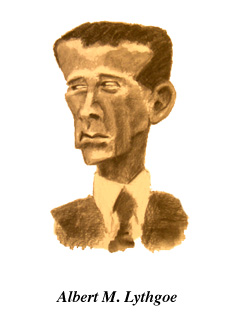
This was way too much for Howard to handle by himself, so he cabled Herbert Winlock's boss and director of the Met, Albert M. Lythgoe. At first he simply asked for the loan of Harry Burton, who was the field photographer for the Met. Albert replied he was only too happy to assist in any way (the news of Tut's tomb had already galvanized the world), and Herbert and others on the Met's crew began to help Howard out.
Problems started right away. First, to simplify dealing with the press (and to get a nice bit of cash), Lord Carnarvon signed an exclusive deal with the London Times. What had happened was the Geoffrey Dawson, the editor of the Times, just showed up uninvited at Highclere to make the deal. Carnarvon was irritated - you never call on an English lord without appointment - particularly since he was just going to have dinner with his friend, the British Egyptologist, Alan Gardiner. Carnarvon pointedly kept Geoffrey waiting an hour and then listened to the proposal. Carnarvon said he'd have to talk with Howard.
As he sat down to dinner with Alan, Carnarvon asked his friend what he thought about a deal with the Times. There was admittedly some logic to it. It would simplify dealing with the press and give them a prestigious forum for announcing their finds. Ah, yes, there was also the money. In any case, Alan thought it was a fine idea. It wasn't, but they didn't find that out until later.
But not much later. Soon all the other newspapers were screaming and foaming how Carter and Carnarvon were profiteering. Who did they think they were? What right did they have to strike a deal like that? Did think they owned the tomb? Well, they didn't own the tomb, but they did own the concession. And the terms of the concession gave them the freedom to handle the press as they saw fit. They certainly had the right, although that doesn't mean it was smart.
But it was the Egyptian papers that really began to gripe. After all, it was their country, for crying out loud, and their Pharaoh. So they had to wait for the lousy English paper to come out before they knew what was going on? All Howard had wanted to do was dig in Egypt and make it pay, but he suddenly found himself having to face Britain's legacy from World War I. After all, John Bull had been preaching that the war to end all wars had been fought that small nations might be free. Naturally the Arabs thought that meant them as much as anyone else.
Before 1918, the Ottoman Empire, based in Turkey, owned the Middle East. It was not the most benign government - in fact, it could be downright nasty. In particular, Arab states - which were culturally and linguistically distinct from Turkey - had seen their citizens shot, hanged, beheaded, and dealt in other distressing manners. So when the war came they naturally aligned themselves with Britain. The British, including their liaison to the Arabs, T. E. Lawrence, let the Arabs think that if they helped Britain win the war, Britain would live up to its rhetoric and grant them independence.
But even before Germany (and so the Ottomans) lost, two gentlemen named Sykes and Picot - one from England, the other from France - met and decided how to best carve up the Middle East leaving England and France in charge. Arabia, because of it's religious importance, had to be given to the Arabs, but France got Lebanon and Syria, and England controlled Palestine and Egypt.
In general, Britain's idea was to gradually ease it's colonies into self-government. This did not mean total independence, but just enough autonomy so the British could be in charge, take it easy, and hopefully make a profit out of what in a few years would be courteously called the British Commonwealth. That was the idea, anyway.
But Britain had problems with Egypt. They were just too damn independent. So when the Egyptians elected a prime minister Britain didn't like, they booted him out of the country. Well, after a few sundry riots and general mayhem, Britian decided Egypt could be free. So in early 1922, the year Tut's tomb was found, Egypt became - officially - an independent country.
But for an independent country, though, there were a lot of foreigners running things. As always, the French largely controlled the Antiquities Department. The British still ran the army (officially protecting the Suez canal and training the Egyptians) with Sir Oliver Lee Stack, the Governor General of the Sudan, in charge. Even Americans were there as some Egyptian courts had American judges. This naturally helped French, British, and American interests. But then (as now) it was kind of hard for the Americans, French, and British to grasp the concept that native inhabitants of a country really do prefer to completely govern themselves rather than have superpowers stand over their shoulders. That included the Egyptians and if that wasn't enough to beat the band, there were some Egyptians that even wanted the British, French, and Americans completely and totally OUT!
One of the people who saw a serious situation arising was none other than Arthur Weigall, Howard's old replacement as Inspector of Antiquities. Since then Arthur had branched into other lines of work (including show business) and had been hired as a special correspondent to the Daily Mail. Now like other reporters he didn't have much to do but sit around and read the Times. But from where he sat he could hear what the Egyptian reporters were saying and was afraid Tut's tomb would be used as a rallying cry by Egyptian nationalists to boot all the foreign powers out. Never a vindictive man, Arthur went to talk to Howard.
Arthur managed to buttonhole Howard one day near the tomb, but Howard wouldn't listen. Finally Arthur wrote Howard a letter and said that the situation was extremely dangerous and that it was necessary that Howard to 1) state clearly that he would not profit from the Times agreement, 2) set aside one day to let all the press into the tomb, and 3) give the Egyptian papers all information the same day he gave it to the London Times. Arthur said he sympathized that Howard was trying to do his work and was also bombarded by the press, politicians, and other visitors demanding to be shown the tomb. But Howard and Lord Carnarvon had to bend a little or there would be real trouble. Howard did bend a little, but not much, and not enough to satisfy anyone.
In the meantime, Howard kept getting the artifacts out of the tomb. With the help of the Met's Egyptian department and other specialists, things actually moved quite fast. By February of 1923 the first room of the tomb had been cleared, and most of the stuff packed up and shipped to Cairo.
Now the big part of the show began. Howard was going to open the burial chamber. On February 16, 1923 with great pomp and fanfare and with invited dignitaries present, the door was carefully chipped down, including the freshly plastered hole which Howard had made to cover up his earlier surreptitious entry. Inside - as Howard knew - was the burial shrine, essentially three successive guilded wood boxes which enclosed the sandstone sarcophagus. Inside the sarcophagus were three mummy coffins, each nested inside the other. The two outer coffins were highly decorated wood. The third was solid gold.
But they couldn't just lift the coffins out. Not only were they so tightly nested that you couldn't even stick a finger between the spaces, the third (innermost) had been drenched in resins as part of the funerary rituals. It was stuck tight into the second. So at the opening, no one was able to see Tut. Ultimately the archeologists had to raise the two coffins up by pins secured between them and then use blow torches to apply heat (with zinc plates strategically placed to protect the coffins). Finally the resins began to soften, and the second coffin slid free.
But by that time Lord Carnarvon was no longer around. He had died on April 5, 1923. The usual story is he nicked a mosquito bite while shaving. The cut had gotten infected, and it developed into pneumonia. In the pre-antibiotic days and for a man Carnarvon's age, that was was often fatal. Despite some alternative explanations (like contracting a fungal or bacterial infection from the tomb), this is the most popular diagnosis.
That is, the mosquito bite is the most popular diagnosis if you forget about the Curse. The Curse of Tutankhamun is the most famous ancient curse in history and is complete baloney. There's no curse inscribed on the doorway or anywhere else in the tomb. It appears to have been something that came out of the newspapers who didn't have much else to write about. In any case, maledictions of any kind never hurt anyone unless the cursee is standing close to the cursor who also happens to have a particularly bad case of halitosis.
What's funny is you find few people who admit
they believe in the Curse, but like a bad penny it just won't go
away. Henry, Lord Carnarvon's son didn't help much in the 1970's when
he said neither believed in the Curse nor disbelieved in it, but no
amount of money could persuade him to enter the tomb. Even people who
know it's garbage worry about it. T. G. H James, at one time
the Egyptian curator at the British Museum, told how when the Tut
exhibit came to the museum in 1972 the foreman of the crew involved
in setting up the exhibit dropped dead. Not in the gallery, but
somewhere else. No one believed this was due to anything but natural
causes, but still the museum officials were so worried the death
would be played up as the "Curse of Tutankhamun", they swore the crew
to secrecy. Amazingly everyone kept their mouths shut about it for
over 20 years.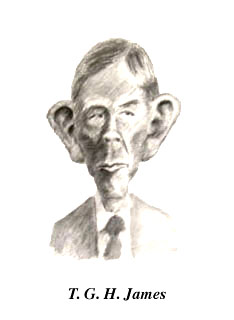
The concession passed on to Lord Carnarvon's wife, Almina. But at about the same time, a change in the Egyptian government occurred. The pro-British government was voted out of office to be replaced with a nationalist administration that wanted the British out of the country. The new minister of Public Works - officially Pierre Lacau's boss - was Morcos Bey Hanna who at one time had been imprisoned by the British for his revolutionary activities. He saw Tut's tomb as a rallying cry against the foreign usurpers. He summoned Howard to his office for a discussion.
When he got there Howard was hoping the 50/50 division rule would hold, although by well accepted rules and precedence it clearly did not. But he certainly saw things were going to get rough when James Tottenham, Pierre Lacau's assistant, called him into his office and said before he met the minister they had to discuss what they meant by an "intact" tomb. James handed Howard a slip of paper that stated "intact" didn't mean it hadn't been robbed. A tomb like that of Yuya and Thuya would qualify. It was in fact the same piece of paper that Howard had signed a number of years before. So Howard realized he was on shaky ground expecting any objects, either for himself, for Lady Carnarvon, or for his buddies at the Met. But that didn't mean he wouldn't try.
One thing that really stung the Egyptians was that Howard was taking the high road, saying he had to be left alone to do his work, but he was also giving nearly daily tours of the tomb to his friends. Howard's friends usually excluded most of the Egyptian government officials and they felt they were being snubbed. Howard said his friends were scientists and the others weren't. The implication was he couldn't be bothered in buttering up the politicians who, the reasoning went, could not appreciate the tomb.
At one point another group of archeologists (ergo, Howard's friends) were coming by, and they had their wives with them. Naturally, the ladies wanted to see the tomb. Sure, said Howard, no problem. But Minister Hanna saw the inconsistency and denied passes for the women, which as head of the Office of Public Works he had the right to do. No scientists, no tour. Howard felt this was an insult to his friends and their wives and also a deliberate smack in the face to him. So in what he thought was a coup of one-upmanship, he packed everything up, closed down the tomb, and stopped excavations. Well, he sure showed them!
Then Howard woke up one morning and found his concession had been revoked. He had, the government said, abandoned the project and endangered the artifacts. They sent their own guards to the tomb, dismissed Howard's, and changed the locks.
Howard, though, felt the takeover was instituted on insufficient grounds. The artifacts were not in danger, and he held the concession which allowed him to dig when he wanted. So he initiated legal proceedings. The court with the jurisdiction over the case was headed by Pierre Crabites, who despite his Continental name, was an American. Toward the end of the hearing Howard's lawyer, F. M. Maxwell, had pretty much won the case. But at the last moment the learnéd Mr. Maxwell stood up and criticized the government for swooping down on the tomb like a bunch of bandits.
Well, the manure hit the slowly turning ceiling fan. It turns out that in Arabic culture "bandit" or "thief" is one of the worst insults you can toss at anyone. The judge tried to get Howard's lawyer to soften his language, but not understanding the significance of the insult, the learned attorney simply repeated it.
Morcos Bey Hanna said he would no longer deal
with Carter even if the court ordered them to do so. The government
would continue the excavations on their own. Unfortunately (or
fortunately depending on your point of view), the government couldn't
find anyone to take Howard's place. The Met was offered the job and
turned it down flat. The Egyptian members of the Antiquities Service
said the task was too much for them to handle. As the weeks and month
dragged on and the tomb sat idle, public opinion began to shift. Even
Egyptian journalists wondered if Howard wasn't the best, maybe the
only, archeologist qualified to do the job. 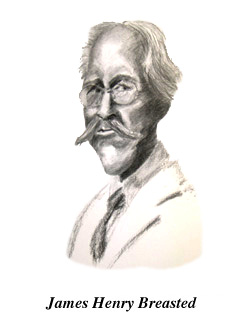
At that point, the venerable James Henry Breasted stepped in. He was America's #1 Egyptologist and went to see Morcos Bey Hanna who was still fuming about being called a bandit. Breasted, who had a gracious and gentle way of dealing with people, came out with a half-promise that Minister Hanna would consider giving Howard a new concession - but it would be with new terms and not be a renewal of the old one. But things kept dragging on, Howard refused to bend, and the tomb remained closed down.
By March 1924, Howard Carter was lecturing in America, and, possibly due to the strain of the events, was exhibiting the worst side of his personality. He would gripe at everyone, waiters, porters, hotel clerks, and even little flower girls. From the account of Howard's manager, when he wasn't lecturing, Howard spent his free time making a complete ass out of himself.
What probably made Howard even more irascible than usual is he had no idea if he'd ever be able to finish the excavation. The Egyptian government was allocating nearly $20,000 - a huge sum in that day - for completing the dig by themselves. Making up for lost time (and to rub Howard's face in the dirt), they opened the tomb for visitors and allowed hundreds of people a day to troop through despite the fact that simply the moisture from the visitors' breath could cause major deterioration of the objects.
Shortly thereafter, Herbert got a copy of the proposed new concession for Howard. The Department of Antiquities said Howard could come back and work on the tomb. But he had to relinquish all rights to the objects and (although it was put in diplomatic language) to quit being such a pain in the rear end. Herbert figured that now since they had hit rock bottom, things could only improve. Boy, was he wrong.
On March 29, Pierre Lacau and a group of his assistants - European and Egyptian - were making an inventory and inspection of the tomb. All was done very correctly with all objects dutifully noted. They checked into the boxes in what was called Tomb Number 4 which was being used for restoration and storage of the objects. They noted how Howard cataloged the objects with a unique triple reference: in the master index, on the box, and on the object itself. The inspection team - including the Egyptians - were clearly impressed by his work.
Then just before quitting they looked in the back of the tomb and saw a stack of boxes. Most were empty Fortnum Mason champagne crates. But one of the boxes was closed and labeled as "Red Wine". Pierre told the men to open it up.
Inside and wrapped in surgical gauze was a
wooden statue the head of Tutankhamun at about the age he became king
or younger. He was shown as the Egyptian God-King rising from the
lotus flower. The statue was carved in the unique "Amarna" style of
art that Akhenaten had developed with the back of the head being
exaggeratedly long. Artistically and historically it was one of the
major finds of the tomb.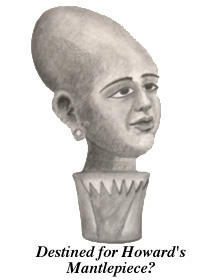
So what was it doing in a box marked "Red Wine", unlabeled and uncataloged? The Egyptian members of the expedition jumped to an immediate (and we have to admit probably correct) conclusion. Howard had ripped it off, and it was probably intended for his mantelpiece.
Amazingly, Pierre defended Howard. There had to be some mistake, he said. He would check with Howard and get the low-down. But the Egyptian inspectors insisted that the statue immediately be sent to Cairo and that the Prime Minister of Egypt - that's the Prime Minister - be informed.
The next day Herbert Winlock (who was back in Egypt) got a visit from Rex Englebach, who was one of Pierre's assistants (Pierre had a lot of assistants). He told Herbert what happened and asked him to contact Howard for an explanation. Without doing so overtly, Rex indicated some possible excuses Howard could use: 1) he bought it on the antiquities market and stored it in the tomb temporarily, 2) a workman made a mistake and put it there by accident and 3) Carter found it in the corridor but forgot to record it. The only problem with the last theory, Rex said, was that Howard showed him what he had found in the corridor, and the statue wasn't there.
Actually Herbert knew everything already. The foreman of Howard's digging crew (and who was loyal to Howard) had been allowed to go on the inspection. After the wooden head had been discovered, he had come to Herbert in a panic and told him the whole story. Now Herbert sent a coded telegram to Howard, still in America, and asked what he should say.
Howard wrote back saying the statue had indeed come from the entrance passageway. At that time he didn't know the extent of the tomb (probably not correct) and was only labeling objects as groups. The statue was in very perishable condition and had taken a lot of restoration to replace the flaked plaster and wood. He had then put it in Tomb #4 for safekeeping. Amazingly Pierre and the Antiquities Department accepted the explanation, partly no doubt, because of it's unique character the statue would go to the Cairo Museum.
The story of the statue in the champagne box wasn't generally known until 1978 when the outgoing director of the Met, Thomas Hoving, told about it in his book "Tutankhamun: The Untold Story". From what he wrote, Tom clearly suspected Howard was going to rip the statue off. Some later writers have doubts about this, but it's really hard to come to any other conclusion. Howard's first volume of "The Tomb of Tutankhamun" had already been published, and there was no mention of the statue. Au contraire (as Pierre might say), the catalog of the stuff found in the entrance passage shows no hint such a find. As far as the records of the excavation go, even pieces of the statue didn't exist until Pierre and the excavation team found it in the wine box.
But for now, Howard took Herbert's cable (which had been clearly marked "To be kept confidential") and his own reply, and no doubt humming merrily, he added it as an appendix to a short pamphlet he was writing. It was a case (some might say a diatribe) against the Egyptian Government and the Antiquities Department. He felt that if the right people read the pamphlet, then the Egyptian government would be on the receiving end of such an outcry of indignation that they would fold up. Then hats in hands, they would crawl to Howard, let him back in the Tomb, and beg him and Lady Carnarvon to pick their share of the contents. He mailed out his copies.
Howard definitely needed a reality check, and he was about to get one. By the time Herbert got his copy, he had returned from Egypt. In fact, he was in his office waiting for Howard to drop by. When Herbert saw his telegrams had been included, he almost blew a vein. Although strictly speaking there was nothing in the note that showed Herbert acted illegally, the tone of the communications was more of what story to come up with rather than to get to the complete and impartial facts. Herbert saw this, although Howard evidently didn't.
Howard showed up at the Met expecting a nice chat with the most amiable of museum curators. Instead he got his tail chewed out. Herbert said he was now unwilling to have anything more to do with Howard, Tut, or anything else Howard might come up with. Howard's attempts to explain his actions came to naught, and soon he found himself booted out of Herbert's office.
Finally Howard realized he had made a shambles of things. He sat down in his hotel room and wrote a letter to Pierre saying he relinquished any personal claim to objects from the tomb. Then after finishing his lecture tour, he returned to Egypt. Still, this was too little too late, and it still wasn't clear if Howard would ever get back to the Tomb of Tutankhamun.
Then on November 18, 1924, Sir Oliver Stack, the British commander, was assassinated on the streets of Cairo by nationalist terrorists. The British immediately took over the country and the native Egyptian government was kicked out. It was replaced with one more favorable to the British. In particular, the new Prime Minister, Ahmed Ziwar, was an old friend of Howard Carter's. So in 1925 and after a personal meeting with Ahmed, Howard began excavations anew. By 1928, the tomb had been cleared of the objects although it took another four years for everything to be restored and cataloged.
But ultimately nothing had changed. By 1930 a new Nationalist government was back in place and almost the first thing on their legislative agenda was to pass a law mandating every object from Tut's tomb would stay in Egypt. That's still where they are, except for a handful of items that some think Howard may have slipped into his pocket and have ended up in various American and British museums. As a coda, though, the Egyptian government did reimburse Lady Carnarvon the expenses of the dig.
As far as the participants in Tut's drama go, if there was a curse, then it was, as T. G. H. James said, a curse that was singularly slow acting. True, Arthur Weigall died relatively young, at age 53, but it was more than a decade after the discovery. He never entered the tomb in any capacity except as a journalist or tourist. Howard Carter himself died in 1939, aged 64 - not particularly young at that time - and not of any curse but of Hodgkin's disease. Herbert Winlock lived until 1950, aged 65, again for the time not an early death.
James Breasted survived until 1935 at the age of 70. Alan Gardiner, his younger colleague who also deciphered some of Tut's inscriptions, was 84 when he died in 1963, the same year as Howard's sometime nemesis, Pierre Lacau, who was 89.
The Carnarvons, except for George, have been exceptionally resistant to Egyptian curses. Lady Carnarvon, who took over the concession after her husband, lived until in 1969, and at over 90, was hardly the victim of a 3000 year old malediction. Her daughter, Lady Evelyn and possibly the first person to have set foot in the tomb, was close to 79 when she died in 1980. Her brother, Henry, the 6th Lord Carnarvon died in 1987, just shy of his 88th birthday.
Highclere Castle is still there, currently owned and managed by the 8th Lord and Lady. You can make arrangements to get a tour, and you can even rent it for conferences and weddings.
And Tut? He's still in his tomb in the Valley of the Kings and not in the best of shape. Everytime they do a study on him, something ends up missing. Shoot, they even ended up loosing that appendage that all men hold most dear. The poor fellow's been talked about, written about, lectured on, dug up, chopped-up, X-rayed, and CAT-scanned. And we still don't even know how he died or who his parents were!
He probably thinks enough is enough.
Part III. References, Commentary, and Discussion
For more details, comments, expostulations, and the occasional diatribe, click on the references.
Print Media
It's hard to believe, but the great information on Tut is still to be found in books and articles.
"The Tomb of Tut-Ankh-Amen" Howard Carter, and A. C. Mace. Cassell, (1923 - 1933) 3 Volumes.
"The Complete Tutankhamun", Nicholas Reeves, Thames and Hudson (1995).
"Tutankhamun: The Untold Story", Thomas Hoving, Simon and Schuster, (1978).
"Howard Carter: The Path to Tutankhamun, T. G. H. James, Tauris Parke (2001).
"Tutankhamen: Life and Death of a Pharaoh", Christiane Desroches-Noblecourt, Graphis Society, (1963).
"The Complete Valley of the Kings: Tombs and Treasures of Egypt's Greatest Pharaohs", Nicholas Reeves and Richard Wilkinson, Thames and Hudson (1996).
"Pioneer to the Past: The Story of James Henry Breasted, Charles Breasted, Charles Scribner's Sons (1943)."
"Akhenaten: Egypt's False Prophet, Nicholas Reeves, Thames and Hudson (2001).
"Akhenaten, Pharaoh of Egypt, A New Study", Cyril Aldred, McGraw-Hill (1968).
"Ikhnaton: Legend and History", Frederick J. Giles, Fairleigh Dickinson University Press, (1972).
"History and Chronology of the Eighteenth Dynasty of Egypt: Seven Studies", Donald B. Redford. University of Toronto Press, 1967.
"The Human Remains From the Tomb of Tutankhamun", F. Filce Leek, Tutankhamun Tomb Series, Volume V, Griffith Institute (Oxford), 1972.
"The Amarna Letters", William Moran, Johns Hopkins University Press, (2001).
"The Murder of Tutankhamen: A True Story", Bob Brier, G. P. Putnam's Sons, 1998 (New York).
"The Skull and Cervical Spine Radiographs of Tutankhamen: A Critical Appraisal ", Richard S. Boyera, Ernst A. Rodina, Todd C. Greya, and R. C. Connolly, American Journal of Neuroradiology Volume 24, pp. 1142-1147, June-July 2003.
"At the Tomb of Tutankhamen", Maynard Williams, National Geographic Magazine, May, 1923.
"The Last Survivor," John Lawton, Aramaco World, pp 10-21 November/December 1981.
"Temples, Tombs and Hieroglyphs: The Story of Egyptology", Barbara Mertz, Dodd, Mead, New York, (1978).
"Ancient Records of Egypt", James Henry Breasted. Russell and Russell, New York (1962).
"Moses And Monotheism" Sigmund Freud. The Hogarth Press, London, 1939, plus many other editions.
For the serious student a number of books about the Egyptian language are available (this list is a single link so you can click anywhere).
"How to Read Egyptian Hieroglyphs: A Step-by-Step Guide to Teach Yourself", Mark Collier and Bill Manly, University of California Press, Revised Edition, 2003.
"Egyptian Hieroglyphic Grammar" Samuel Mercer, Ares Publishers, 1980.
On line resources are de rigeur these days. They are also seductive, easy to use, and at times not all that accurate. However, these seem to be among the more reliable. For comments on the sites, click here.
"Tutankhamun: Anatomy of an Excavation", http://www.ashmolean.org/gri/4tut.html
"False Images of Tutankhamun", Ahmed Osman, http://ahmedosman.com/tut_images.html
"TourEgypt.Net" http://www.touregypt.net/
"The Pronunciation of Ancient Egyptian", http://www.friesian.com/egypt.htm
"Basic Lessons in Hieratic", http://home.prcn.org/sfryer/Hieratic/index.html
Egyptology Online, http://www.egyptologyonline.com
"Who was buried in KV55?" Tony High, EgyptOnline http://www.egyptologyonline.com/kv55_the_discovery.htm
"Tutankhamun's CS Scan", http://www.egyptologyonline.com/ct_scan_report.htm
Visual Media
"King Tut's Final Secrets", National Geographic Society, 2005, 95 minutes.
Return to Tutankhamun's Archaeologists Caricatures
Return to Herbert Winlock Caricature
Return to CooperToons Home Page